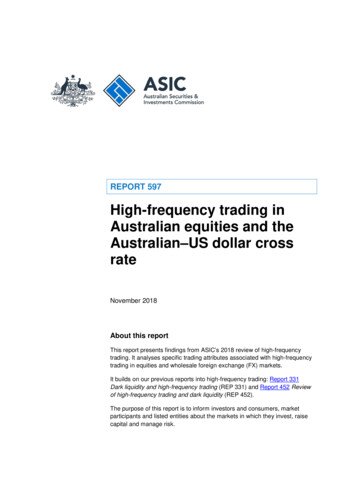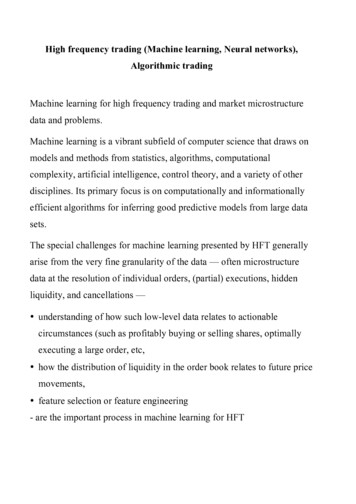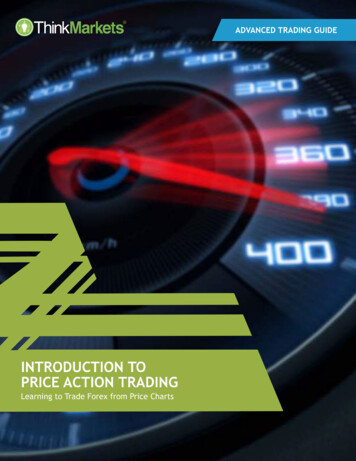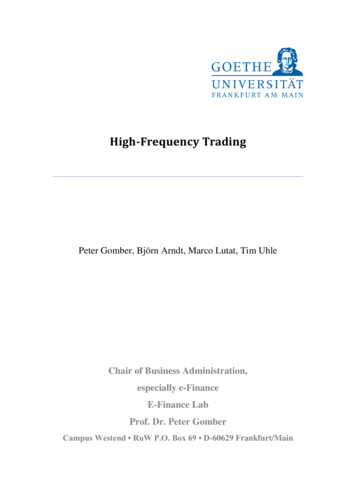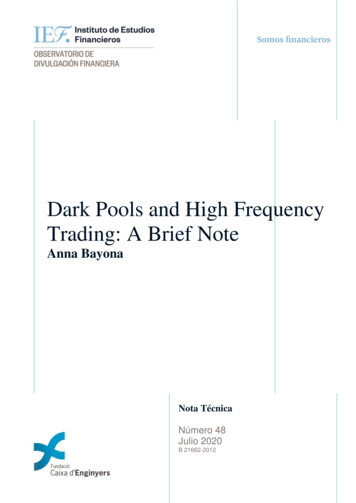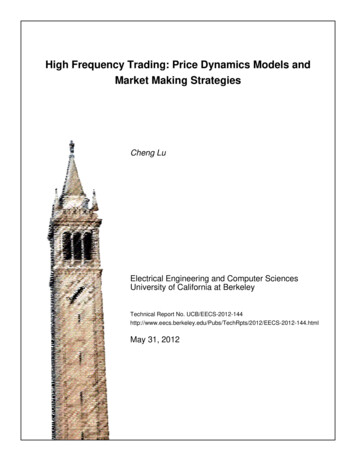
Transcription
High Frequency Trading: Price Dynamics Models andMarket Making StrategiesCheng LuElectrical Engineering and Computer SciencesUniversity of California at BerkeleyTechnical Report No. /TechRpts/2012/EECS-2012-144.htmlMay 31, 2012
Copyright 2012, by the author(s).All rights reserved.Permission to make digital or hard copies of all or part of this work forpersonal or classroom use is granted without fee provided that copies arenot made or distributed for profit or commercial advantage and that copiesbear this notice and the full citation on the first page. To copy otherwise, torepublish, to post on servers or to redistribute to lists, requires prior specificpermission.
High Frequency Trading:Price Dynamics Models and Market Making StrategiesCheng Lu23269284Electrical Engineering and Computer ScienceIn partial fulfillment of therequirements for the Degree ofMaster of EngineeringUniversity of California at Berkeley
AbstractHigh Frequency Trading (HFT) has recently drawn public and regulatory attention afterthe “flash crash” in U.S. stock market on May 6, 2010. Data processing and statisticalmodeling techniques in finance has been revolutionized by the availability of highfrequency data on transactions, quotes and order flow in electronic order-driven markets,which has and brought up new theoretical and computational challenges. Marketdynamics at the transaction level cannot be characterized solely in terms the dynamics ofa single price and one must also take into account the interaction between buy and sellorders of different types by modeling the order flow at the bid price, ask price andpossibly other levels of the limit order book. In this paper, I implemented and improved aqueuing model that characterizes the market dynamics as a Discrete Markovian System,which is more suitable for illiquid market. I then propose and examine a fewmarket-making trading strategies & applications of such a model and point to thesimulation results.Keywords: High-Frequency Trading, Markovian Queuing Model, Market MakingStrategies.i
Table of ContentAbstract .i1Introduction . 12Literature Review . 43Methodology. 83.1Model Setup . 83.2Model Modifications . 113.2.1 Event Arrival Rate . 113.2.2 Order Size . 153.2.3 Event Correlation . 163.3Model Application. 183.3.1 Market Making . 183.3.2 Market Making with balancing strategy . 193.3.3 Smoking Strategy . 204Discussion. 234.1Model Simulation Results . 234.2Market Making Simulation Results. 244.3Market Making With Balancing Simulation Results . 264.4Smoking Strategy Simulation Results . 285Conclusion . 326Reference . 33ii
1 IntroductionAlgorithm trading of stock first became a significant part of Wall Street in the 1980s.Since then, more powerful computers and more sophisticated algorithms have grownvastly. For years, High-Frequency Trading (HFT) firms stepped away from Wall Street,reaping billions of revenue while being criticized as damaging markets and hurtingordinary investors. Now, after the 2008 Crisis, they are stepping into the light.There are plenty of definitions of High-Frequency Trading. HFT is a strategy that tradesfor investment horizons of less than a day and seeks to unwind all positions before theend of each trading day. Because they must finish the day flat, high-frequency tradersmust exhibit balanced bi-dimensional flow, thus HFTs can’t accumulate large positionand deploy large amount of capital, and they have little need for outside capital, so tendto be proprietary traders. The opportunities of HFT usually come from taking theopposite side of trades of long-term investors, who will impact many securities besidesthe one they are directly traded, because stocks are correlated. This creates opportunitiesfor HFTs, whose activities keep correlated stocks “fairly priced” with respect to oneanother. It is worth to notice that the primary driver of growth in HFT market is reducingtrading costs, not the technology. As trading cost diminish, including bid/ask spread,1
commissions, market access fees and SEC fees, smaller and smaller opportunitiesbecome profitable to trade, leading to higher HF volume.There are several distinct characteristics that differentiate HFT from traditional long-terminvestment. The HFT’s average net profit margin, transaction costs, capital requirementsand total profit potential are all far smaller than long-term investment, and while HFThave higher consistency of profits than long-term investment too. The opportunities forshort-term returns follow a Gaussian distribution, and HF traders target opportunities thatare tiny but plentiful. Since HFT opportunities are short-lived, capturing them requiresuses of advanced technology. HFT requires speed to capture opportunities beforecompetitors access them.HFTs are the backbone of market liquidity and serve as an important part of the market’secosystem for long-term investors. Market makers contribute immediately transactableshares at prevailing prices. Statistical Arbitrageurs make sure that information is efficienttransmitted from securities being impacted by long-term investors to other securities thatare correlated, resulting in cross-sectional fair prices. HFTs risk their own capital toprovide their services, yet earn razor-thin margins for doing so.High-frequency trading changes the behavior of all market participants, and calls for newmodels for understanding market dynamics and providing quantitative frameworks foroptimal execution of trades and accurate prediction of market variables. In this paper, I2
implemented and improved the Discrete Markovian Queuing model to characterize thedynamic of HFT market, to HFT data, which recorded the Limit Order Book of aHK-traded stock for one week. I assume that the model could accurately simulate the realmarket behavior, upon which I apply and test different trading strategies. The finaldeliverable includes a market simulation model and several feasible trading strategies.The rest of the paper is organized as follows: In the Literature Review Section, I presentthe review of state of the art research developments in HFT market. In the MethodologySection, I introduce the hypothesis, implementation and improvement of the DiscreteMarkovian Queuing Model, and then presented several market-making trading strategiesand their associated simulation results. Finally, in the Conclusion Section, I give briefconclusion about my HFT capstone project.3
2 LiteratureReviewThe electronic platforms form a limit order book aggregating most trading data in afinancial market every day. At the same time, the frequency of order submissions hasincreased and the time for market order execution on electronic markets has droppedfrom more than 25 milliseconds to less than a millisecond in the past decade. As a result,the evolution of supply, demand and price behavior in equity markets is beingincreasingly recorded, and this data is available to all market participants in real time andto researchers in the forms of high frequency database. The analysis of such highfrequency data constitutes a challenge. At a fundamental level, statistical modeling ofhigh frequency market provide insightful analysis of the dynamics between order flow,liquidity and price dynamics [4, 5, 6], and might help bridge the gap between marketmicrostructure theories [7, 8, 9]. At the level of applications, models of high frequencydata provide a quantitative framework for market making [10] and optimal execution oftrades [11, 12, 13]. Another obvious application is the development of statistical modelsin view of predicting short-term behavior of market variables such as price, tradingvolume and order flow.At any given time in a limit order market, outstanding limit orders are represented by thelimit order book, which summarizes the price and quantity of supply and demand. Notsurprisingly, empirical studies [14] indicates that the state of the order book contains4
information about short-term price movements so it is of great interest to providestatistical model for the dynamics of the order book.R. CONT, KUKANOV and STOIKOV [4] suggested a conceptually simple model thatrelates the price changes to the order flow imbalance (OFI) defined as the imbalancebetween supply and demand at the best bid and ask prices. Their study reveals a linearrelationship between OFI and price changes. However, statistical results reveal that thislinear relationship may not be the case, so I will be more interested in other sophisticatedmodels that take into account more factors.R.CONT and A. DE LARRARD characterized it by a heavy traffic model [1]. In theheavy traffic limit, the possibly complicated discrete dynamics of the queuing system isapproximated by a system with a continuous state space, which can be either describedby a system of ordinary differential equations or a system of stochastic differentialequations. The bid/ask queue sizes follow the diffusive behavior and it is important toconsider the diffusion limit of the order book. When the sequences of order sizes at thebid and the ask and inter-event durations are weakly dependent covariance-stationarysequences, the rescaled order book process converges weakly to a two-dimensionalMarkov process diffusing in the quarter-plane, which is ‘renewed’ every time it hits oneof the axes. And before each time the process renewed, it is a two-dimensional Brownianmotion. However, it is noticed that the heavy traffic assumption is problematic for my5
data because the Hong Kong listed stock is not sufficiently traded, so characterized it bycontinuous Brownian motion would cast severe deviation from reality. Therefore I need a“fine-grained” model that is able to track individual orders.R. CONT and LARRARD [2] recently proposed a discrete stochastic model for thedynamics of a limit order book, in which arrivals of market order, limit orders and ordercancellations are characterized in terms of a Markovian queuing system. Through itsanalytical tractability, the model allows to obtain analytical expressions for variousquantities of interest such as the distribution of the duration between price changes, thedistribution and autocorrelation of price changes, and the probability of an upward movein the price, conditional on the state of the order book. This model meets my expectationsquite well, but I also found that the data I have do not satisfy some assumptions they put,for instance, the duration of events is not exponentially distributed. I then try to modifythe original model to accommodate facts from empirical studies of the data.As for the application level, current states of art researches have been focused onelectronic market making and technical analysis. Y. NEVMYVAKA, K. SYCARA, andD. SEPPI [15] established an analytical foundation for electronic market making in whichthey focused on the normative automation of the market maker’s activities. They utilizedthe “non-predictive” trading strategies to highlight the fundamental issues: depth of quote,quote positioning and timing of updates. They also examined the impact of various6
parameters on the market maker’s performance. Similarly, Y. FENG, R. YU, P. STONE[16] examined an automated stock-trading agent in the context of thePenn-Lehman-Automated-Trading (PLAT) simulator, which devised a market makingstrategy exploit market volatility without predicting the exact stock price movementdirection. Understanding the market maker’s activities and exploring the different marketmaking strategies have become the research focus in high-frequency market. Inspired bythese ideas, and together with an accurate market dynamics model, I would be able tobetter analysis the market maker’s activities and providing profitable strategies.7
3 MethodologyHaving argued in the above section that the Hong Kong listed stock I have is not liquidand hence the key assumption of the heavy traffic model is not satisfied, I start from adescription of order arrivals for different kinds of orders, the dynamics of a limit orderbook is naturally described in the language of queuing theory [2]. Motivated by the factthat it is sufficient to focus on the dynamics of the best bid and ask queue if one isprimarily interested in the level I order book dynamics, I then decided to follow theMarkovian queuing model [2] to test its validity on the data where the limit order book isdriven by orders at the bid and ask side, represented as a system of two interactingMarkovian queues. I will first introduce the setup of R. CONT’s queuing model [2], andthen elaborate my modifications according to the empirical analysis.3.1 ModelSetupTo simplify the initial model, we use the following terms to represent the limit orderbook: The bid price s bt and the ask price sta stb δ , which captures the majority of themarket situation. The size of the bid queue qtb represents the outstanding limit buy orders at the bid.8
The size of the bid queue qta represents the outstanding limit buy orders at the ask.The state of the limit order book is thus described by the triplet X t (stb ,qtb ,qta ) , whichtakes values in the discrete state space δ . 2 .The state X t of the order book is updated by order book events: limit orders (at the bid orask), market orders and cancelations. According to the R.CONT’s works [2], I got theassumption that these events occur according to independent Poisson processes: Market buy (resp. sell) orders arrive at independent, exponential times with rate µ . Limit buy (resp. sell) orders at the (best) bid (resp. ask) arrive at independent,exponential times with rate λ . Cancellations occur at independent, exponential times with rate θ . These events are mutually independent. All orders sizes are equal (assumed to be 1 without loss of generality). All the previous sequences are independent.Under these assumptions qt (qtb ,qta ) is thus a Markov process, taking values in 2 ,whose transitions correspond to the order book events {Ti a ,i 1} {Ti b ,i 1} .9
When the bid or ask orders is depleted, the price moves up or down to the next level ofthe order book. Analogous to the heavy traffic model, the new queue sizes are sampledfrom the empirical PDF f b/a (x, y) . I further assume that the order book contains noempty levels so that these price increments are equal to one tick (in our case, 0.05 HKD): When the bid queue is depleted, the price decreases by one tick. When the ask queue is depleted, the price increases by one tick.In summary, the process X t (stb ,qtb ,qta ) is a continuous-time process withright-continuous, piecewise constant sample paths whose transitions correspond to theorder book events {Ti a ,i 1} {Ti b ,i 1} [2]. At each event: If an order or cancelation arrives on the ask side i.e. T {Ti a ,i 1} :(sTb ,qTb ,qTa ) (sTb ,qTb ,qTa Vi a )1q a V a (sTb δ , Rib , Ria )1q a V aT iT iIf an order or cancelation arrives on the bid side i.e. T {Ti b ,i 1} :(sTb ,qTb ,qTa ) (sTb ,qTb Vi b ,qTa )1qb V b (sTb δ , R'bi , R'ia )1qb V bTiT i(Vi a )i 1 and (Vi b )i 1 are sequences of IID variables, (Ri )i 1 (Rib , Ria )i 1 is a sequence ofIID variables with (joint) distribution f b (x, y) , and ( R'i )i 1 ( R'bi , R'ia )i 1 is a sequence ofIID variables with (joint) distribution f a (x, y) .10
3.2ModelModifications3.2.1 EventArrivalRateIn R. CONT’s original model [2], all kinds of orders arrive at an exponential rate, which Idoubt maybe is not the case in our data, so I run some empirical study about the orderarrival rate. I first differentiated 6 different kinds of orders from our data, which is: LimitBuy Orders, Limit Sell Orders, Market Buy Orders, Market Sell Orders, CancellationBuy Orders, and Cancellation Sell Orders. In our terms, Limit Buy means someoneposted a buy order at the best bid, and Limit Sell means someone posted a sell order atbest ask. Market Buy means someone takes the best bid offers, and Market Sell meanssomeone takes the best ask offers. Cancellation Buy means someone cancelled their bidorders at the best bid, and Cancellation Sell means someone cancelled their ask orders atthe best ask. Fig 1 shows the empirical probability distribution of the six different kindorders arrival rate:11
Limit Buy OrdersLimit Sell 20406080Market Buy Orders100120140160180200Market Sell 00350400450002040Cancellation Buy Orders6080100120140160Cancellation Sell 040050060000100200300400500600Fig 1. Order arrival distribution and the exponential distribution.In Fig 1, the white line indicates the best fitted exponential distribution. It is observedthat, in some cases, the exponential distribution fits the data well, such as limit buy ordersand market sell orders, but in some other cases, such as cancellation buy orders andmarket buy orders, the exponential distribution obviously fails to fit the data.This empirical study suggests that one potential threat of R. CONT’s Queuing Model [2]might be the exponential arrival rate, so I try to figure out another distribution that maycapture the arrival rate better than exponential, and I found one candidate after some trialand error, which is called Weibull Distribution, which is often used to describe the size12
distribution of particles. The probability density function of a Weibull random variable xkis f (x; λ ,k) k / λ (x / λ ) k 1 e ( x/ λ ) 1(x 0)I then try to fit the arrival rate using the Weibull distribution. The results are shown in Fig2:Limit Buy OrdersLimit Sell 20406080Market Buy Orders100120140160180200Market Sell 00350400450002040Cancellation Buy Orders6080100120140160Cancellation Sell 040050060000100200300400500600Fig 2. Order arrival distribution and the Weibull distribution.In Fig 2, the white line indicates the exponential distribution and the red one is theWeibull distribution. To access the goodness of fitting, I also look at the Q-Q plots asshown in Fig 3.13
Fig 3. Q-Q plots of the real data against the Weibull distribution or the exponentialdistribution.In Fig 3, it shows the comparison between the Weibull distribution and the exponentialdistribution in each order figure. The blue lines indicate the authentic data, while the redlines are the calculated distribution. The closeness indicates the accuracy of thedistribution to the real data. One can then clearly see that nearly for each figure, theWeibull distribution outperforms Exponential, especially for Limit Sell Orders, MarketBuy Orders, Cancellation Buy Orders and Cancellation Sell Orders, where we say thatthe Weibull distribution is really a good fit to the data. After these empirical studies, I14
decided to use the Weibull distribution instead of the exponential distribution tocharacterize the arrival rate of different orders.3.2.2 OrderSizeAnother concern I have about the original model is the assumption that all coming ordershave unit lot size (400 shares), which I believe is quite biased from the reality. I first runa study to analyze the order size distribution, as is shown in Fig 4.Limit Buy OrdersLimit Sell 050006000700080009000 1000000100020003000Market Buy Orders400050006000700080009000 10000700080009000 10000700080009000 10000Market Sell 050006000700080009000 1000000100020003000Cancellation Buy Orders400050006000Cancellation Sell 50006000700080009000 1000000100020003000400050006000Fig 4. Order size distribution.15
It’s obvious to see that the order size follows an exponential distribution as well, which Ibelieve is close to the reality, so I decided to add order size as another random variable toform a compound renewal process, in which we use the Weibull distribution again tocharacterize its dynamics.3.2.3 EventCorrelationThe last doubt I have is that I believe all the events should have some inner connectionbetween each other, whereas the original model claims that orders are independent. I firstcalculated the correlation between all kind of orders arrival duration and its related size inChart 1.Chart 1. Order duration and size correlation matrix.16
The above 12 12 correlation matrix is distributed as following: Limit Buy OrdersDuration at the first row, Limit Buy Orders Size at the second row, Limit Sell OrdersDuration at the third row, Limit Sell Orders Size at the forth row, and so on. Thehighlighted items are those with high correlation, and I pick them up in Chart 2.Chart 2. High correlation entries.One thing I found really interesting is the correlation between limit buy duration andmarket sell duration. The high correlation could be explained by the basic economicprinciples, where limit buy orders represented demand. The high demand will boost theprice, according to the economic principles, so people will tend to buy more shares togain profit, and that’s why market sell orders appears so soon. Another interesting fact isthat the size correlation is relatively small, so we could say that the size is an independentfactor in the queuing system. So I integrated the correlation of limit buy duration and17
market sell duration using the same empirical distribution function f (x, y) , as isdescribes in the previous session.3.3 ModelApplicationAfter having the Markovian queuing model discussed above, I hypothesized that themodel could accurately simulation the dynamics of the real market. Having thishypothesis in mind, I start to test multiple trading strategies based on this model,especially for market makers.3.3.1 MarketMakingIn practice, it is of great interest to understand the mechanism of basic market makingactivities and the impact of possible strategies. Intuitively, market makers reap profits byposting same size ask and bid order simultaneously, selling highly and buying low. Here,I consider the following model problem. Suppose the market maker posts N shares attime t, and he is obliged to close his position with completion time T, that is, close Nshare position in [t,t T ] . The market maker could post limit order on any level of orderbook he want, and he is expecting other traders in the market could hit both his bid orderand ask order. The market maker must close his position at time t T by purchasing(selling) the remaining position at market price. The most important decision the marketmaker has to make is which level he should put the order at. It’s conceptual obvious thatposting orders at a deeper position (closer to market price) will increase the execution18
probability while acquiring small profit, and posting orders further will get more profit bytaking more risk. In reality, most market maker will have a targeting profit margin andrisk tolerance threshold. Then it is not obvious quantify the results of putting orders ondifferent levels. I tested this market making strategies with different completion time T,number of shares N and level of order placement by running independent Monte Carlosimulation. The results will be analyzed in the Discussion session.3.3.2MarketMakingwithbalancingstrategyThe previous study on the market making activities is the simplest version. Here, weconsidered a more complex situation. Normally, rather than leaving the portfolio aloneafter posting the initial shares at time t (which is the assumption in the previous strategy),most market makers will follow the trend of the market and modify the portfolioaccording to the market performance in real time. One normal strategy is to rebalance theposition around the current price, since it assures the equal probability for both sides to beexecuted. Here, besides the model problems in the previous session, I also integrated thebalancing strategy, which shows as follows:At each end of time interval Δt If currently no position is on the best level and both bid and ask size hasn’t beendepleted yet, rearrange the remaining shares to be balanced around the currentmarket price.19
If both sides haven’t been depleted and the current price is already balanced,decrease the margin of both sides by one tick. If one size already depleted, try to increase the other side by one tick.In the model setup, I ignore the cancellation fee for cancellation the original orders, sincein most exchanges, there will be a “liquidity award” for posting limit order, which isapproximately the same amount of the cancellation fee. I tested this balancing strategiesagain with different completion time T, number of shares N and level of order placementby running independent Monte Carlo simulation. The results will be analyzed in the nextsession.3.3.3 SmokingStrategyIt is highly interesting to understand the high frequency market maker’s trick beyond thebasic market making strategy. One of the widely used strategies is called SmokingStrategy. High-Frequency traders place small alluring quotes to attract other side’smarket order. Suppose another party detects this alluring quote (usually throughautomated trading system), they will then send out a market order. Since market ordersare only executed at the best market price, HF traders can cancel the quotes before themarket orders arrive, thus letting the other party hits the large shares previous posted byHF traders. Fig 5 illustrated one example of the smoking strategy.20
Fig 5. An example of smoking strategy.The smoking strategy could be happened in both ask and bid side. The key for thesmoking strategy is the speed, which is exactly the advantage of high-frequency traders. Iexamined the 5 days Hong Kong traded stock data I have, and found out that there are 20occurrences happened in 5 days (7 bid side, 13 ask side). The average alluring quote sizeis 7,280 shares, the average cancellation duration is 1.98s, and the average tradingvolume is 2,160 shares. The histogram of cancellation duration is shown in Fig 6.21
14121086420012345678910Fig 6. Cancellation duration histogram.Understood that the prime parameter for the success of smoking strategy is thecancellation duration, I tested the smoking strategy based on the model by runningindependent Monte Carlo simulation. The result will be discussed in the next session.22
4 Discussion4.1 ModelSimulationResultsTo sum up the methodology, I employed a Markovian Queuing Model [2] whosetransition corresponds to the order book events {Ti a ,i 1} {Ti b ,i 1} . There are six kindsof orders in the system. For limit buy orders and market sell orders, I use the empiricalprobability distribution to generate the simulation queue. Other than that, thecorresponded Weibull distribution is used. The order size and duration are seen asindependent to each other. The final simulation queue contains around 12,000 events in aday. The details are documented in Chart 3.Chart 3. Discrete event simulation statistics.23
Based on this queue, I ran a simple simulation to test the validity of this model. Thesimulation starts with the first price of the first day, and one sample path is shown in Fig7 where the red line is the real first day data, and the blue line is the simulated result. Onecan tell that the simulation results catch the sense of our market pretty 012000140001600018000Fig 7. A sample path of simulated stock prices.4.2 MarketMakingSimulationResultsAccording to the previous discussion, I tested the market making strategy based on theMarkovian Queuing System. The parameter is nLevel, which range from 0 to 5,24
representing the level market maker put the orders; Completion Time T, which rangefrom 3600s to 18000s (1 to 5 hours), representing the total amount of time for closing theposition; Number of shares N, which range from 400 to 2,000, representing the totalshares used by the market making strategy. The results are shown in the followingfigures:Comple
dynamic of HFT market, to HFT data, which recorded the Limit Order Book of a HK-traded stock for one week. I assume that the model could accurately simulate the real market behavior, upon which I apply and test different trading strategies. The final deliverable includes a market simulation model


